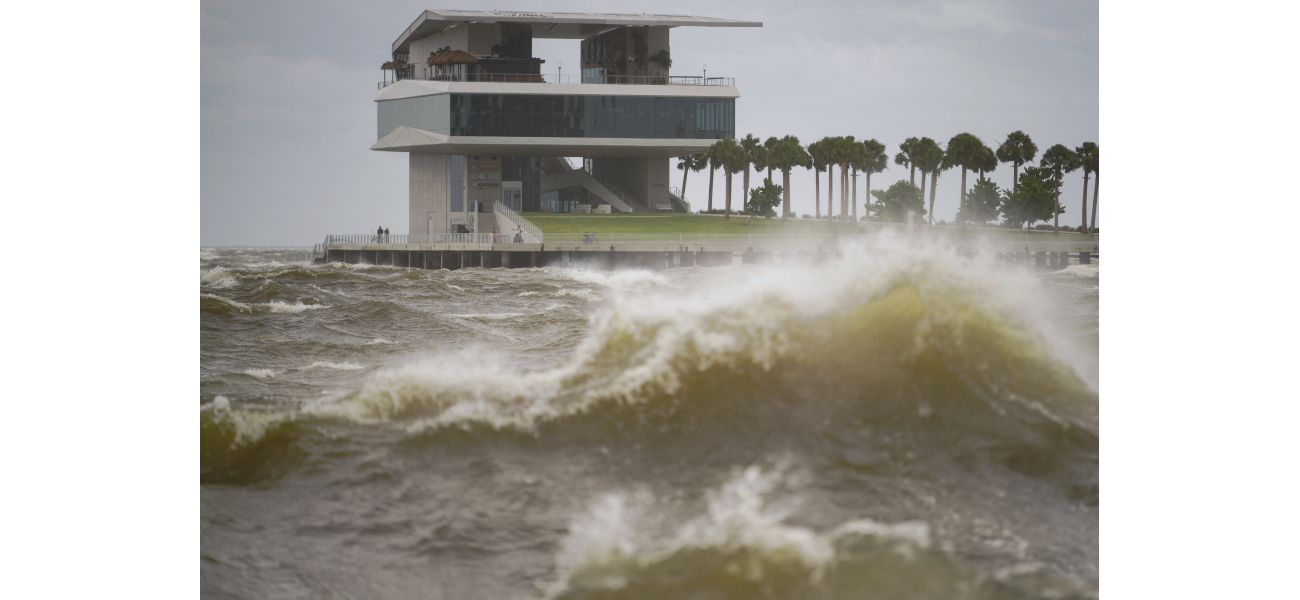Category 4 hurricane Helene hits northwestern Florida.
Strong winds cause power outages in multiple states, prompting emergency declarations and affecting over 250,000 properties.
September 27th 2024.

The powerful and rapidly-moving Hurricane Helene has struck the northwestern coast of Florida as a Category 4 storm, bringing with it the potential for catastrophic storm surges, damaging winds, heavy rains, and flash floods. This dangerous storm has also caused destruction and loss of life inland across the southeastern United States.
As the storm approached, authorities in Georgia reported two fatalities, possibly caused by a tornado, and Florida Governor Ron DeSantis confirmed one death on Interstate 4 when a sign fell onto a car. The impact of the storm has been widespread, knocking out power to over 1 million homes and businesses in Florida and over 50,000 in Georgia.
To prepare for the storm, states of emergency were declared in Florida, Georgia, the Carolinas, Virginia, and Alabama. The severity of the situation was evident as Governor DeSantis warned of potential additional fatalities and property damage, urging people to stay safe and keep those affected in their thoughts and prayers.
Meanwhile, in the Pacific, former Hurricane John has regained strength as it approaches Mexico's western coast, threatening flash flooding and mudslides. In the Atlantic, Tropical Storm Isaac has formed and is expected to strengthen as it moves away from the US. Forecasters predict it could become a hurricane by the end of the week.
Back in Florida, Governor DeSantis reported that one person had died while driving on Interstate 4, emphasizing the dangerous conditions caused by the storm. He urged people to take necessary precautions and warned that more fatalities were possible as the storm continues to move through the state. He also announced that 3,500 National Guardsmen were ready to assist with any response efforts.
The National Hurricane Centre in Miami confirmed that Hurricane Helene made landfall in northwestern Florida as a Category 4 storm with maximum sustained winds of 140 mph. The centre also warned of catastrophic flooding along the Gulf Coast, particularly in Florida's Apalachee Bay.
As of 11 p.m. EDT, over 885,000 customers in Florida were without power, and the storm's reach extended far beyond the coast, with hurricane and flash flood warnings in effect for areas as far north as western North Carolina.
In the Pacific, former Hurricane John has been downgraded to a tropical storm as it moves slowly along the coast of Mexico's Michoacan state. Despite the downgrade, the storm is still causing significant damage, with wind speeds of 70 mph and the potential for severe flash flooding.
Overall, both Hurricane Helene and former Hurricane John have caused widespread destruction and devastation, reminding us of the unpredictable and destructive nature of these natural disasters.
On Thursday evening, Hurricane Helene, a fast-moving storm, reached the Big Bend area of Florida's northwestern coast as a powerful Category 4 storm. This brought with it a potential for catastrophic storm surges, damaging winds, heavy rains, and flash floods across the southeastern US, even hundreds of miles inland. According to forecasters, the storm posed a serious threat to the safety and well-being of the residents in its path.
As the storm approached, two people in Georgia were reported to have been killed in a possible tornado. This was followed by the tragic news of another fatality in Florida, where a person driving on Interstate 4 was struck by a falling sign. Florida Governor Ron DeSantis expressed his concern for the safety of his state's residents, urging them to take caution and stay indoors. He also mentioned that more lives could potentially be lost as the storm continues its destructive path.
The impact of the hurricane was evident as it knocked out power to over 1 million homes and businesses in Florida and 50,000 in Georgia. Emergency states were declared in several states, including Florida, Georgia, the Carolinas, Virginia, and Alabama, as they braced for the storm's impact.
In the Pacific, another hurricane, John, was gaining strength and was expected to bring flash flooding and mudslides to areas along the western coast of Mexico. Meanwhile, Tropical Storm Isaac had formed in the Atlantic Ocean and was forecasted to potentially become a hurricane by the end of the week as it moved away from the US.
Governor DeSantis, in a late-night press conference, urged residents to be prepared for the worst and to keep those affected in their thoughts and prayers. He mentioned that additional fatalities and property damage were expected, and urged people to take necessary precautions.
Helene officially made landfall in northwestern Florida, near Perry, with maximum sustained winds of 140 mph. The National Hurricane Centre warned of "catastrophic" flooding along the Gulf Coast, with storm surges expected to reach up to 20 feet in Florida's Apalachee Bay. The hurricane warnings and flash flood warnings extended far beyond the coast and into northern Georgia and western North Carolina.
As the storm continued to wreak havoc, power outages in Florida continued to rise, with over 885,000 customers left without power. The majority of these outages were concentrated in the Big Bend area, where Helene made landfall.
In the meantime, John, which had initially made landfall in Mexico as a Category 3 hurricane, was downgraded to a tropical storm as it slowly moved along the coast of Michoacan. However, it still posed a threat of severe flash flooding in coastal areas. The storm had previously caused significant damage, blowing off roofs, triggering mudslides, and toppling trees. After weakening inland, it regained strength and was classified as a hurricane again on Thursday.
The US National Hurricane Centre predicted that John would continue to weaken and eventually dissipate as it moved further into the ocean. However, the damage it had already caused was significant, and it served as a reminder of the destructive power of these natural disasters.
As the storm approached, authorities in Georgia reported two fatalities, possibly caused by a tornado, and Florida Governor Ron DeSantis confirmed one death on Interstate 4 when a sign fell onto a car. The impact of the storm has been widespread, knocking out power to over 1 million homes and businesses in Florida and over 50,000 in Georgia.
To prepare for the storm, states of emergency were declared in Florida, Georgia, the Carolinas, Virginia, and Alabama. The severity of the situation was evident as Governor DeSantis warned of potential additional fatalities and property damage, urging people to stay safe and keep those affected in their thoughts and prayers.
Meanwhile, in the Pacific, former Hurricane John has regained strength as it approaches Mexico's western coast, threatening flash flooding and mudslides. In the Atlantic, Tropical Storm Isaac has formed and is expected to strengthen as it moves away from the US. Forecasters predict it could become a hurricane by the end of the week.
Back in Florida, Governor DeSantis reported that one person had died while driving on Interstate 4, emphasizing the dangerous conditions caused by the storm. He urged people to take necessary precautions and warned that more fatalities were possible as the storm continues to move through the state. He also announced that 3,500 National Guardsmen were ready to assist with any response efforts.
The National Hurricane Centre in Miami confirmed that Hurricane Helene made landfall in northwestern Florida as a Category 4 storm with maximum sustained winds of 140 mph. The centre also warned of catastrophic flooding along the Gulf Coast, particularly in Florida's Apalachee Bay.
As of 11 p.m. EDT, over 885,000 customers in Florida were without power, and the storm's reach extended far beyond the coast, with hurricane and flash flood warnings in effect for areas as far north as western North Carolina.
In the Pacific, former Hurricane John has been downgraded to a tropical storm as it moves slowly along the coast of Mexico's Michoacan state. Despite the downgrade, the storm is still causing significant damage, with wind speeds of 70 mph and the potential for severe flash flooding.
Overall, both Hurricane Helene and former Hurricane John have caused widespread destruction and devastation, reminding us of the unpredictable and destructive nature of these natural disasters.
On Thursday evening, Hurricane Helene, a fast-moving storm, reached the Big Bend area of Florida's northwestern coast as a powerful Category 4 storm. This brought with it a potential for catastrophic storm surges, damaging winds, heavy rains, and flash floods across the southeastern US, even hundreds of miles inland. According to forecasters, the storm posed a serious threat to the safety and well-being of the residents in its path.
As the storm approached, two people in Georgia were reported to have been killed in a possible tornado. This was followed by the tragic news of another fatality in Florida, where a person driving on Interstate 4 was struck by a falling sign. Florida Governor Ron DeSantis expressed his concern for the safety of his state's residents, urging them to take caution and stay indoors. He also mentioned that more lives could potentially be lost as the storm continues its destructive path.
The impact of the hurricane was evident as it knocked out power to over 1 million homes and businesses in Florida and 50,000 in Georgia. Emergency states were declared in several states, including Florida, Georgia, the Carolinas, Virginia, and Alabama, as they braced for the storm's impact.
In the Pacific, another hurricane, John, was gaining strength and was expected to bring flash flooding and mudslides to areas along the western coast of Mexico. Meanwhile, Tropical Storm Isaac had formed in the Atlantic Ocean and was forecasted to potentially become a hurricane by the end of the week as it moved away from the US.
Governor DeSantis, in a late-night press conference, urged residents to be prepared for the worst and to keep those affected in their thoughts and prayers. He mentioned that additional fatalities and property damage were expected, and urged people to take necessary precautions.
Helene officially made landfall in northwestern Florida, near Perry, with maximum sustained winds of 140 mph. The National Hurricane Centre warned of "catastrophic" flooding along the Gulf Coast, with storm surges expected to reach up to 20 feet in Florida's Apalachee Bay. The hurricane warnings and flash flood warnings extended far beyond the coast and into northern Georgia and western North Carolina.
As the storm continued to wreak havoc, power outages in Florida continued to rise, with over 885,000 customers left without power. The majority of these outages were concentrated in the Big Bend area, where Helene made landfall.
In the meantime, John, which had initially made landfall in Mexico as a Category 3 hurricane, was downgraded to a tropical storm as it slowly moved along the coast of Michoacan. However, it still posed a threat of severe flash flooding in coastal areas. The storm had previously caused significant damage, blowing off roofs, triggering mudslides, and toppling trees. After weakening inland, it regained strength and was classified as a hurricane again on Thursday.
The US National Hurricane Centre predicted that John would continue to weaken and eventually dissipate as it moved further into the ocean. However, the damage it had already caused was significant, and it served as a reminder of the destructive power of these natural disasters.
[This article has been trending online recently and has been generated with AI. Your feed is customized.]
[Generative AI is experimental.]
0
0
Submit Comment





